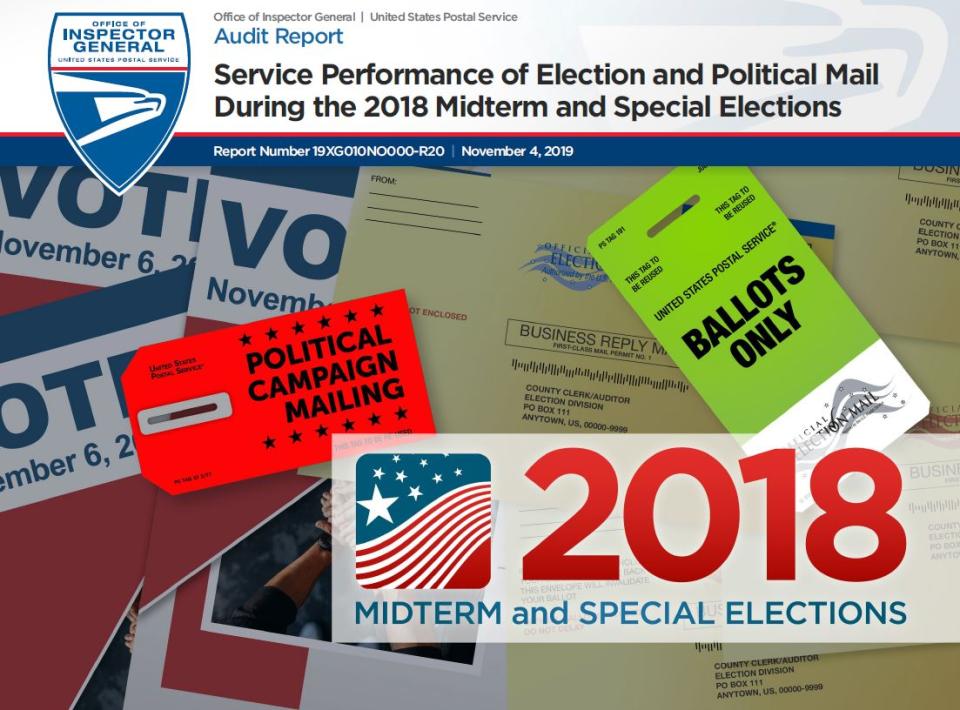Service Performance of Election and Political Mail During the 2018 Midterm and Special Elections
Objective
Our objective was to evaluate the U.S. Postal Service’s performance in processing Election and Political Mail for the 2018 midterm and special elections. The Postmaster General requested this audit. We previously reviewed the Processing Readiness for Election and Political Mail for the 2018 Midterm Elections and issued a report in June 2018. Midterm and general elections are held in the U.S. every two and four years, respectively. Special elections are held outside of this cycle for specific purposes, often to fill a vacant office. The next general election will be held on Tuesday, November 3, 2020.
Election Mail is a mailpiece that an authorized election official creates for voters participating in the election process. Election Mail is generally First-Class Mail and its service standard ranges from 1-3 days. Service standards specify timeliness targets for delivering mail after receiving it from a customer. Management determines service standards based on the class of mail, where it originates, and where it is going, or destined. Generally, the farther the mail must travel, the more days for the service standard. The Postal Service measures its mail service performance against these service standards. The service performance goal for First-Class Mail is 96 percent.
Political Mail is any mailpiece mailed for political campaign purposes by a registered political candidate, a campaign committee, or a committee of a political party to promote political candidates, referendums, or political campaigns. Political Mail is Marketing Mail and its service standard ranges from 3-10 days within the Continental U.S. The target for Political Mail is 91.80; however, based on our work, we found that facilities typically process Political Mail as First-Class Mail.
After evaluating the Postal Service’s performance for processing Election and Political Mail for the period January through October 2018, we conducted interviews with Postal Service plant officials at the highest and lowest performing sites in each of the seven Postal Service areas based on service performance. In addition, we interviewed headquarters officials and area and district Political and Election Mail coordinators.
High-performing sites — the Seattle Priority Mail Annex, WA; and the Oklahoma City, OK; Knoxville, TN; Norfolk, VA; Southern ME; Bakersfield, CA; and Madison, WI, Processing & Distribution Centers (P&DC) were the seven highest performing locations for Election and Political Mail and averaged 99.6 percent on-time performance.
Low-performing sites — the Eau Claire, WI; Royal Palm, FL; Cleveland, OH; Suburban, MD; Dominick V. Daniels, NJ; Anaheim, CA; and Fox Valley, IL, P&DCs were the seven lowest performing locations for Election and Political Mail and averaged 84.2 percent on-time performance.
What the OIG Found
We found that the Postal Service’s nationwide service performance score for Election and Political Mail was 95.6 percent, or slightly below its goal of 96 percent. However, we also determined that 70 percent of Postal Service facilities with Election and Political Mail volume greater than two million mailpieces met or exceeded the service performance goal and averaged 98.3 percent on-time performance.
Management at the seven high-performing sites attributed their success to the following critical factors:
- Three had timely and frequent communication with all levels of plant staff. For example, Political and Election Mail coordinators communicated with mail processing plant, post office, and area managers to discuss potential problem areas.
- Four had personnel separate and identify Election and Political Mail from other mail in the facility to improve processing in compliance with the Election and Political mail standard operating procedures.
Management at the seven low-performing sites attributed poor performance to the following factors:
- Six did not reassign mail processing staff to accommodate peak Election and Political Mail volume periods.
- Six encountered mailpiece design issues such as improper mailpiece size and barcodes.
- Four were unsure how to track Election and Political Mail service performance using the new Informed Visibility application.
Not meeting mail service performance goals increases the risk of customer dissatisfaction, which could lead to reduced business for the Postal Service and a potential loss of revenue. In addition, timely delivery of Election and Political Mail is necessary to ensure the integrity of the U.S. election process.
What the OIG Recommended
We recommended management:
- Ensure sufficient mail processing staff are assigned to appropriately process peak Election and Political Mail volume.
- Ensure continued outreach to mailers and election officials on proper mailpiece design.
- Provide training and guidance to applicable staff on obtaining Election and Political Mail service performance in the Informed Visibility application.

